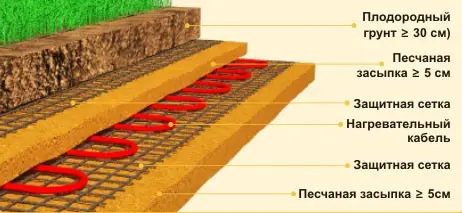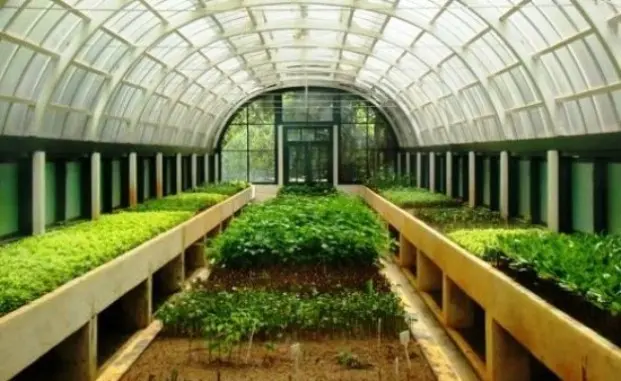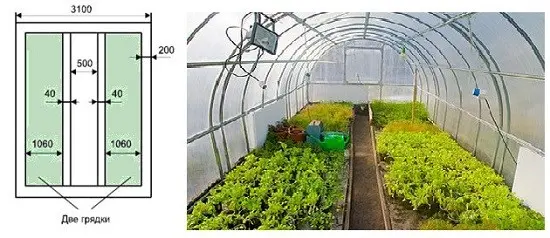Contents
Greenhouses and greenhouses are a popular way of gardening. The special arrangement of the greenhouse inside gives us the opportunity to harvest earlier than in the open field. And with the development of technology, equipping greenhouses has become a simple matter. For example, cellular polycarbonate is very useful – a lightweight and durable material from which you can quickly mount a greenhouse of any size.
What must be required
The height of the polycarbonate greenhouse should be such that nothing prevents the gardener from taking care of the plants, and there is enough space for climbing plants.
Inside, depending on the width, there should be two or three beds and paths between them. The width of the beds is calculated in such a way that it is possible to take care of the plants without stepping on the soil. Therefore, in narrower greenhouses, the beds are placed along the walls and made with a maximum width of a meter. If the greenhouse is wide, then the bed in the center can be made up to one and a half meters wide. The paths should be about 50 cm. But the arrangement of the greenhouse inside is not only beds, but also heating, ventilation and watering.
Polycarbonate greenhouses are usually heated by sunlight. This is enough to grow good crops. For better light transmission, the walls and roof should be cleaned at least twice a season. For better heat accumulation, the northern side of the greenhouses is painted black.
But, if the greenhouse is used for growing seedlings or early vegetables, which means that work in it begins even in winter, additional heating cannot be dispensed with. For example, you can install a warm floor in a capital greenhouse.

Greenhouses can be ventilated manually; for this, several vents must be provided in the design that can be opened during the day. It is important to remember that ventilation with an open door and a window open opposite it is a draft, which, on the contrary, is harmful to plants. The best option is one or two open windows on the side wall. In addition, there are various automatic ventilation systems for sale specifically for greenhouses – in case there is a summer resident who cannot check the condition of the plants and the temperature in the greenhouse every day.
Watering plants is most conveniently done using an automatic system. Through it, fertilizers can be applied in liquid form.
Video “Heated floor in the greenhouse”
This video summarizes the underfloor heating system in the greenhouse after a year of use.
Shelving Tips
The arrangement of a greenhouse for growing seedlings is the installation of racks and shelves. In addition, you can combine – leave beds with undersized plants at the lower level, and make racks above. Due to the ability of polycarbonate to pass the maximum amount of sunlight, there will be enough lighting for all plants.

Racks allow you to use the space to the maximum, because they can be made two or three tiered. The width of the racks is similar to the width of the beds – that is, about eighty centimeters with access from one side and up to one and a half meters if there is access from two sides. It makes sense to install sectional racks – these can be easily taken out of the greenhouse and returned back if the plants on which they are planted require hardening in the open air.
The main tier of the racks is the one on which work with plants, transplanting and picking will take place. It should be convenient for the summer resident in the first place in height. The best option is the same height as the kitchen table.
Under the rack you can store the necessary equipment or agricultural chemistry.
Beds and paths
The width of the track in a polycarbonate greenhouse is determined by two parameters. Since the maximum useful use of the internal space is necessary, the track should not be too wide. On the other hand, especially for large greenhouses, the path cannot be too narrow for a wheelbarrow, for example, with a tomato crop, to pass through it.
At the same time, the paths should be made of non-slip material – perhaps from boards or bricks. It is irrational to leave the paths unpaved, since when watering the greenhouse, especially high beds, water can accumulate on such paths. In a capital greenhouse, you can equip paths with a slight slope and a drain along the edge.

Beds are the main element of any greenhouse. It would be optimal to make high beds, with a minimum height of twenty to twenty-five centimeters above the greenhouse floor. The benefit of such beds is that they warm up better and can be filled with properly prepared soil. A problematic place in high beds is too good drainage, which will require watering more often.
To arrange a high bed, the landing site must be fenced with a curb of boards, tiles or slate with a height of twenty-five centimeters, and the fence, which will subsequently be subjected to serious pressure by the soil layer, should be fixed. The easiest option is to drive pegs along the entire garden, on both sides of the curb. The pool obtained in this way must be laid with a fine-mesh net to protect against pests, then covered with prepared soil mixture.
Soil requirements for each type of plant are different. Of course, in gardening stores you can find ready-made mixtures for greenhouses suitable for a particular crop, but this is an expensive pleasure. Therefore, most summer residents prefer to prepare the soil with their own hands, mixing garden soil, humus, sand, peat, sawdust and other additives in the right proportions. Regardless of the composition of the soil mixture, before using it in the greenhouse, it must be steamed to destroy harmful microorganisms.
In the event that climbing plants are planted in the garden, supports must be provided for them.
Other decor
The arrangement of the greenhouse in the capital version also provides for a quarantine zone, a place to store equipment and other additional features.

The easiest way to organize a quarantine zone is with an aquarium. When introducing new seedlings or pots of plants into the greenhouse, you need to make sure that the plants themselves are healthy and the soil is not infected with harmful microorganisms. To do this, “newcomers” are kept in a completely isolated area. You can assemble it yourself from profiles and glass or polycarbonate, or you can use a ready-made aquarium. The only requirement for the quarantine zone is that it should be in the coolest and most shaded place in the greenhouse so that the plants inside do not overheat.
Sometimes in the greenhouse additional lighting is required. For example, infrared lamps. For adult plants, this is too expensive, but the benefits for seedlings are undeniable.
Video “How to choose a lamp for plants”
A large harvest directly depends on the quality of plant lighting. This video will help you understand the plant lamps and choose the most suitable one.









